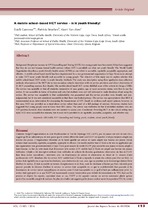| dc.description.abstract | BACKGROUND: Despite an increase in HIV Counselling and Testing (HCT), few young people have been tested. It has been suggested
that they do not test because formal health services (where HCT is provided) are often not youth friendly. The World Health
Organisation describes a youth-friendly health service (YFHS) as one which is accessible, equitable, acceptable, appropriate, and
effective. A mobile school-based model has been implemented by a non-governmental organisation in Cape Town in an attempt
to make HCT more youth friendly and accessible to young people. The objective of this study was to explore whether this
mobile school-based HCT service is youth friendly. METHODS: The study was descriptive, using three qualitative data collection
methods: observation of the HCT site at two secondary schools; interviews with six service providers; and direct observation of
21 HCT counselling sessions. KEY RESULTS: The mobile school-based HCT service fulfilled some of the criteria for being a YFHS.
The service was equitable in that all students, irrespective of race, gender, age, or socio-economic status, were free to use the
service. It was accessible in terms of location and cost, but students were not well informed to make decisions about using the
service. The service was acceptable in that confidentiality was guaranteed and the service providers were friendly and nonjudgemental,
but it was not considered acceptable in that there was limited privacy. The service was appropriate in that HCT is
recommended as an intervention for decreasing the transmission of HIV, based on evidence and expert opinion; however, in
this case, HCT was provided as a stand-alone service rather than part of a full package of services. Moreover, studies have
suggested that young people want to know their HIV status. The service was ineffective in that it identified students who are
HIV positive; however, these students were not assisted to access care. CONCLUSION: Providing HCT in the school setting may
make HCT more accessible for students, but it needs to be provided in an equitable, accessible, acceptable, and effective way. | en_US |
| dc.rights | # 2016 The Author(s). Published by Informa UK Limited, trading as Taylor & Francis Group.
This is an Open Access article distributed under the terms of the Creative Commons Attribution License (http://creativecommons.org/licenses/by/4.0/),
which permits unrestricted use, distribution, and reproduction in any medium, provided the original work is properly cited. | |

